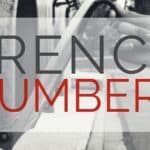
In this post I discuss almost every type of French number and ways of talking about numbers and number operations in French (and in some cases, in Switzerland and Belgium).
WHOLE NUMBERS
Let’s start with the normal, counting numbers (or whole numbers). Individual digits in a number are chiffres (feminine); quantities of numbers are nombres (masculine).
Zero through twelve
Just like in English, the numbers 0-12 in French are unique words.
| Zero | Zéro |
| One | Un |
| Two | Deux |
| Three | Trois |
| Four | Quatre |
| Five | Cinq |
| Six | Six |
| Seven | Sept |
| Eight | Huit |
| Nine | Neuf |
| Ten | Dix |
| Eleven | Onze |
| Twelve | Douze |
Thirteen, fourteen, fifteen, sixteen
Then, in English, when we begin to add “-teen” as the numbers go higher, French continues to have its own “separate” words for 13 through 16.
| Thirteen | Treize |
| Fourteen | Quatorze |
| Fifteen | Quinze |
| Sixteen | Seize |
Seventeen, eighteen, nineteen
At 17, French numbers start to have their version of the “-teen” ending, by adding dix (10) and a hyphen in front of the number to be added to dix.
| Seventeen | Dix-sept |
| Eighteen | Dix-huit |
| Nineteen | Dix-neuf |
The TWENTIES
At twenty (vingt), French is back to having a unique word for the number, just like in English.
Starting from 21, and for every multiple of ten going higher (31, 41, 51, etc.) until 91, the pattern will be the base number + et un (“and one”, or et onze, as we’ll see in a minute). The et will only be added when the number ends in 1.
For twenty-two to twenty-nine, the pattern is “vingt” + hyphen + the ones digit number.
| Twenty | Vingt |
| Twenty-one | Vingt et un |
| Twenty-two | Vingt-deux |
| Twenty-three | Vingt-trois |
| Twenty-four | Vingt-quatre |
| Twenty-five | Vingt cinq |
| Twenty-six | Vingt-six |
| Twenty-seven | Vingt sept |
| Twenty-eight | Vingt-huit |
| Twenty-nine | Vingt-neuf |
Thirty to Sixty-Nine
This pattern continues until sixty-nine. Vingt (20) looks a little different from dix (ten), but for 30, 40, 50, and 60, you should be able to notice the similarity with the 0-10 version of the number. Trente (30) is similar to trois (3); quarante (40) is similar to quatre (4), etc.
Thirty is trente; remember the et un rule for 31, making it trente et un; and thirty-two is trente-deux, etc. Here’s 40, 50, and 60, as well:
| Thirty | Trente |
| Forty | Quarante |
| Fifty | Cinquante |
| Sixty | Soixante |
SEVENTIES
In traditional “France” French, there is no separate word for seventy. (Does this get confusing for an English speaker? Absolutely. And see below for a side note on what other French-speaking countries use.)
Instead, sixty (soixante) gets added to each number until seventy-nine. Note that seventy-one still follows the et pattern before the second number (onze). When you hear a phrase that begins with soixante, get in the habit of waiting until the full number is spoken before assuming the number is 60 something, because it might actually be 70 something.
| Seventy | Soixante-Dix |
| Seventy-one | Soixante et Onze |
| Seventy-two | Soixante-Douze |
| Seventy three | Soixante-Treize |
| Seventy four | Soixante-Quatorze |
| Seventy-five | Soixante-Quinze |
| Seventy six | Soixante-Seize |
| Seventy-seven | Soixante-Dix-sept |
| Seventy eight | Soixante-Dix-huit |
| Seventy nine | Soixante-Dix-neuf |
The EIGHTIES
The word eighty in French literally means “four-twenties” (quatre-vingts).
That may seem odd, as we don’t usually think of quantities of twenty as anything special in English. But there is an old-fashioned word for them: score, which shows us that thinking of things in groups of twenty was more common once. Have you heard of the “four score and seven” phrase in the Gettysburg Address, or “The days of our years are threescore years and ten” in the Psalms Bible verse?
The exact source of the “four twenties” concept existing in French is debated, but the general belief is that it is a remnant of a culture that used a “base 20” number system impacting the Early French language, perhaps from the Celts.
There is an s at the end of quatre-vingt only when the number is eighty itself.
The Nineties
The 90s are a combination of the –dix, –et-onze, –douze, endings as the 70s, along with the quatre-vingt beginnings in the 80s.
Try to minimize the amount of math you do as an English speaker when you’re hearing numbers. First, get used to hearing quatre-vingt and immediately translating it to “eighty” in your head. Then, just like with soixante, you’ll have to get used to waiting until the end of the phrase when you hear numbers that begin in quatre-vingt, in case the number is not actually 80 something, but 90 something.
| Ninety | Quatre-vingt-dix |
| Ninety-one | Quatre vingt onze |
| Ninety-two | Quatre-vingt-douze |
| Ninety-three | Quatre-vingt-treize |
| Ninety four | Quatre-vingt-quatorze |
| Ninety five | Quatre vingt-quinze |
| Ninety six | Quatre-vingt-seize |
| Ninety seven | Quatre-vingt-dix-sept |
| Ninety-eight | Quatre-vingt-dix-huit |
| Ninety-nine | Quatre-vingt-dix-neuf |
Alternate versions of 70, 80, and 90 in Switzerland and Belgium
In Switzerland and Belgium they often (or exclusively) use septante (70), huitante (80), and nonante (90).
I’ve never personally tried to use the non-French versions of the numbers in France, but many people online say that French people either don’t understand the word or will clarify the number you’ve said by using the “France” version of the number, it wouldn’t save you much time if you’re trying to communicate in France. Just memorize the France versions. (But if you’re staying in Switzerland or Belgium, definitely use their versions!)
ONE HUNDRED
Finally, we’re back to a single word: one hundred, or cent.
The et un (or et onze) pattern from 21 to 91 is dropped after 100. Everything will be cent + the one or two-digit number (keep the hyphenation, if there is any, in the tens and ones place number).
From there, two hundred is deux cents, three hundred is trois cents, etc. Just like with eighty (quatre-vingts), the s is only at the end for the round number itself.
| One hundred | Cent |
| One hundred one | Cent un |
| One hundred two | Cent deux |
| One hundred seventeen | Cent deux dix-sept |
| One hundred three | Cent trois |
| Two hundred | Deux cents |
| Two hundred one | Deux cent un |
| Three hundred | Trois cents |
| Four hundred | Quatre cents |
| Five hundred | Cinq cents |
| Six hundred | Six cents |
| Seven hundred | Sept cents |
| Eight hundred | Huit cents |
| Nine hundred | Neuf cents |
If you ever want to talk about a quantity there are “hundreds of” but you don’t know the exact number, use centaines, not cent.
The Thousands
The same pattern of the hundreds continues until “thousand,” or mille (don’t get mille confused because it looks a little like “million;” mille is similar to how a millimeter is one-thousandth of a meter).
An s does not go after mille, even for whole thousands, so it’s deux mille, dix mille, cent mille, etc. Also, when you are talking about “one thousand”, you don’t need to say une before mille.
| one thousand | mille |
| two thousand | deux mille |
| three thousand one | trois mille et un |
| three thousand two | trois mille deux |
| three thousand seventeen | trois mille dix-sept |
The bigger numbers
Finally, here are the largest numbers you’ll probably ever need to know in French. Note that French doesn’t have a separate word for trillion; instead, it’s “thousand billions.” Also, un million is a noun, so you always have to say the number of millions, even if it’s just one, and add an s at the end if it’s more than one million. The same rule applies for milliards.
| one million | un million |
| two million | deux millions |
| billion | milliard |
| trillion | mille milliards |
Math Vocabulary
This is an overview of the main points on how mathematical operations are talked about in French.
Decimals, Fractions, and Percentages
Decimals are separated by commas in French, with spaces in long numbers where you would use commas in English. Instead, use a comma to indicate a decimal point.
6,500,900 stars → 6 500 900 étoiles
50.75 pieces → 50,75 pièces
Percentages
Percent is spelled out as pour cent, but in French, the % sign is used, as well.
75 percent of the planet → 75 pour cent de la planète
Fractions
For any fraction where you’re referring to one over another number, all fractions past 1/4 are simply un + the whole number version with -ième added to the end. Fractions are always masculine except un demi, which can sometimes be une demie.
| a half | un demi (une demie if it’s used referring to a feminine noun) |
| a third | un tiers |
| a fourth | un quart |
| a fifth | un cinquième |
| a sixth | un sixième |
| a seventh | un septième |
| an eighth | un huitième |
| a ninth | un neuvième |
| a tenth | un dixième |
With a fraction that is not 1 over another number, the numerator and the denominator are formed much like they are in English, with the denominator plural.
| three quarters (3/4) | trois quarts |
| two-thirds (2/3) | deux tiers |
| four-fifths (2/5) | quatre cinquièmes |
When you are talking about a fraction of something in a sentence, de should follow the fraction (modified by the gender and quantity of the noun) and precede the noun. I wrote more about how to use de la, du, and des here.
two-fifths of the animals → deux cinquièmes des animaux
seven-eighths of the shelf → sept huitièmes de l’étagère
a quarter of the book → un quart du livre
Arithmetic
Finally, let’s talk about how the French describe basic arithmetic functions (plus, minus, times, and divided by).
four plus two equals six → quatre plus deux égal six
eight minus ten → huit moins dix
seven times eleven → sept fois onze or sept multiplié par onze
ten divided by five makes two → dix divisé par cinq font deux
| plus | plus |
| minus | moins |
| times or multiplied by | fois or multiplié par |
| divided by | divisé par |
| equals | égal (singular form) or font (plural form) |
Other POSTS
That’s all on French numbers! On a somewhat similar topic, I talk about how to discuss dates and time in French on this post.



